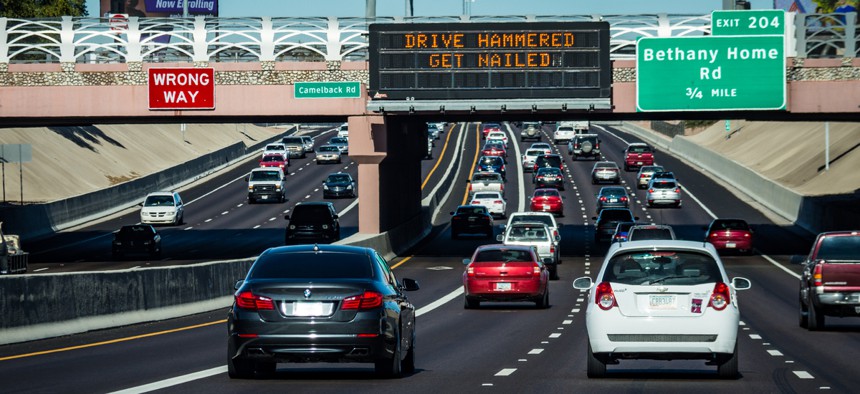Traffic Deaths Have Gone Up. What Can Governors Do About it?

Interstate 17 in Phoenix Shutterstock

Connecting state and local government leaders
"If we had 100 people lost to natural disasters or terrorist attacks every day, we would mobilize immediately," said Deborah Hersman, president and CEO of the National Safety Council.
WASHINGTON — Traffic crash deaths have been on the rise in the U.S. and governors are uniquely positioned to do something about it, according to experts who spoke at an event here Tuesday.
There were 37,461 traffic-related fatalities in the U.S. in 2016, based on National Highway Traffic Safety Administration data. That's the equivalent of about 102 people killed per day, and marks a 5.6 percent increase over 2015, which saw the greatest year-over-year increase in traffic deaths since 1966.
Contributing to the rise in fatal crashes are factors like improvements in the economy, which have more people traveling on roads, risky behavior like distracted and drunk driving and speeding, and post-crash difficulties like long distances to hospital trauma centers.
"If we had 100 people lost to natural disasters or terrorist attacks every day, we would mobilize immediately," said Deborah Hersman, president and CEO of the National Safety Council.
“When we think about what needs to happen when it comes to highway safety, it's about convening people, establishing a vision and collaborating with others," she added. "Governors are in a unique opportunity to do that on behalf of their constituents."
At Tuesday's event, which was sponsored by the National Governors Association, the NGA and the Centers for Disease Control and Prevention both highlighted new resources designed to help states cut down on traffic crashes.
Staff with the National Governors Association released a report that highlights existing methods to combat traffic crashes and outlines steps governors and others can take to improve road safety programs.
CDC representatives, meanwhile, detailed an updated version of an online calculator that enables state officials to punch in the amount of money they have to spend on traffic safety and then, based on that figure, helps them develop a customized set of recommended "interventions" they can put in place to prevent fatalities and injuries.
Specific interventions might include actions like increasing fines for seatbelt violations, or implementing helmet laws for motorcyclists.
It's not only motorists who are killed using roadways. The NGA report notes that 5,987 pedestrians and 840 bicyclists died in traffic-related crashes in 2016.
There were also, overall, an estimated 4.6 million injuries requiring medical care that were linked to crashes. Although traffic injuries can be harder to gather data on than fatalities.
Certain age groups also face outsized risks. For instance, the report points out that motor vehicle crashes remain the leading cause of death for American teenagers and that half of all teens will be involved in a car crash before graduating from high school.
Distracted driving has been an area getting attention in recent years with the rise of smartphones and in-car features like GPS. With at least 3,477 fatalities in 2015 distraction was a factor, the NGA report says.
Jonathan Adkins, executive director of the Governors Highway Safety Association, acknowledged technology, drugged driving and other emerging issues with traffic safety.
"But we also need to be really clear," he added. “What’s killing people are still the big three: seat belts, drunk driving and speed."
Bill Lucia is a Senior Reporter for Government Executive's Route Fifty and is based in Washington, D.C.

NEXT STORY: Male Mayor Bucks 'Overwhelming Male Power Structure' in City Hall





